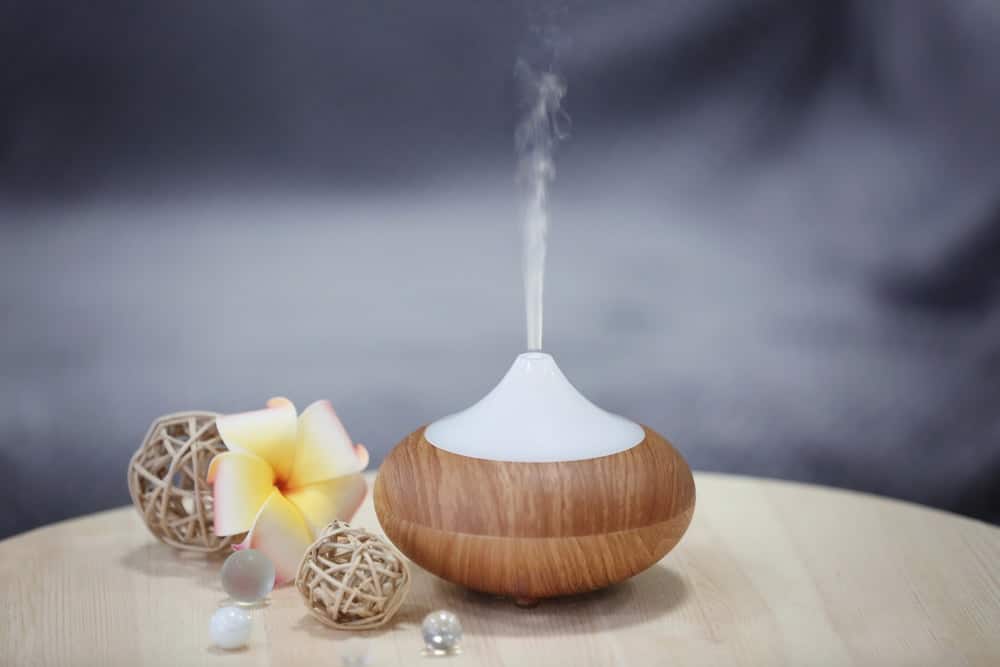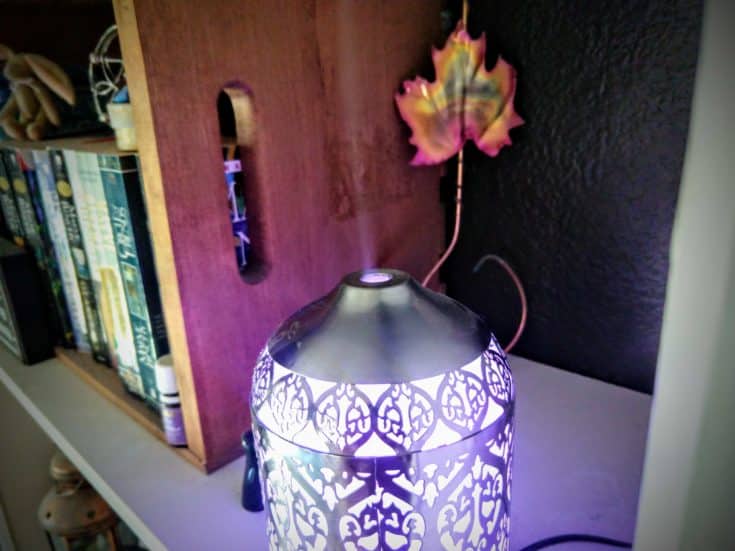Essential oil diffusion is an uncomplicated process and is an excellent way to take advantage of aromatherapy and natural air freshening techniques. In fact, it is one of the best ways to be introduced to essential oil use and to determine which scents are preferable and to discover what benefits they have for your lifestyle.
The following guide explains how to use an essential oil diffuser, with an emphasis on ultrasonic diffuser use since they are one of the most widely available. Their popularity surrounds their availability and many variances in style all while providing a wide range of budget needs.
Types of Diffusers

Diffusers are technically defined by anything that diffuses or allows particles of a concentrated substance to be distributed into a less saturated space, such as surrounding atmosphere. Reed diffusers depend on capillary action to draw liquid through cohesion and do not require any sort of electricity to run. The scent of the oil is then dispersed through evaporation. These are popular, but not for large space dispersal, which requires the use of a nebulizing, or ultrasonic diffuser.
Ceramic pot diffusers work in a similar manner since the clay they are made from will draw the oil into its porous surface and then diffuse it into the surrounding air via evaporation. Others may use a candle to heat oil that sits in a small container, but it isn’t suggested to heat essential oils if you want to keep all their beneficial properties intact.
Nebulizers are very cool looking contraptions that depend on pressurized air to help draw oil through a narrow tube and then disperse it into the surrounding air. They are very carefully designed to allow this process to occur properly and are considered artworks as they are often designed from blown glass and carved wood.
Ultrasonic diffusers can also be quite aesthetically pleasing but come in a wide variety of shapes, sizes, and designs to fit budget needs. They use a thin ultrasonic membrane and vibration to mix and diffuser oil and cool water into the air- providing both scent and humidity. They are very effective, with many also providing a light source of some sort.
This article focuses on this popular diffuser option to help you see exactly how it works, how to care for it, and why it is an excellent way to diffuse your oils.
Mistakes to Avoid

The use of a diffuser is generally safe, but as with any electronic- care should be taken. This is also true of essential oil use. Essential oils are a strong concentrate of naturally occurring plants, but that doesn’t mean they are inherently safe to use. Be sure to follow these tips to ensure a safe and enjoyable diffusing experience.
Oil Toxicity and Allergic Reactions
Not all oil is meant to be inhaled, although most are considered safe to do so. Responsible companies will provide transparency concerning use and warnings if any concerns exist in reference to their oils. Also, not everyone is tolerant of all the components found in essential oils, and if you have sensitivities or allergies you should check with your healthcare provider in advance to avoid any reactions or complications.
Also- not all animals do well with certain oils, in fact, some are downright toxic. Be sure to check these in advance to avoid any complications.
Citrus Oils and Plastic
Citrus oils have a chemical composition that interferes with plastic over time. Using these in plastic diffusers may eventually see a breakdown in how well it works.
Oil Quality

Always use a pure, undiluted essential oil in your diffusers. It is common for people to choose larger, less expensive bottles of essential oils from a local pharmacy thinking they are saving money, but what they don’t realize is that even though there is 100% oil in the bottle, it is already most likely diluted with a carrier. Businesses that deal exclusively with oil and oil products, such as Young Living, will have transparency in their ingredients and provide you a drop count.
For example, a 5 ml bottle of pure, concentrated essential oil will have approximately 75-80 drops of oil that you can dilute on your own of various purposes. Many bottles that include a carrier may not disclose this and only be labeled 100% oil- and contain perhaps only 10 drops of true essential oils altogether.
The problem with this is a carrier oil usually has a fatty acid in it, which can stick to diffuser parts and create problems. For example, floats that measure water amounts may not work properly and allow for an overflow, which could be problematic when it comes in contact with the electronics of the diffuser.
Length of Diffuser Use
It truly only takes about 20 to 40 minutes of diffuser use to saturate a room with the microscopic droplets. This allows you to take advantage of their benefits for up to 4 hours depending on the oil. Running diffusers for long lengths of time only wastes oil and energy. Try running at intervals throughout the day rather than all at once.
Spills
These diffusers so use water and accidents can happen. And since electronics are involved that can be problematic. Be sure to have a spill plan in place to unplug and get the water and oil up quickly.
How to Keep Your Diffuser Clean

Diffusers require very little in the way of maintenance to keep them working as they should- but they do require regular care. You can follow our step by step cleaning guide, which basically describes what parts of your diffuser needs attention and cleaning to ensure it is diffusing as it should. The most common problem is a build up of mineral buildup from your water, as well as oil residue being left behind.
The good thing is even a very neglected diffuser will clean up easily and quickly with a few simple cleaning steps. Wiping your diffuser down regularly will help keep you from having to do much at all, but not paying attention to it can result in it not working properly, if at all.
How to Use an Ultrasonic Diffuser
Although the use of a diffuser seems pretty self-explanatory and doesn’t need a lot of detailed steps, it doesn’t hurt to consider to following steps to ensure you are getting the most out of your machine. Everything from proper placement, to the water and oils you use, need to be considered.
Step 1: Placement

Where you choose to set your diffuser can make a difference pertaining to more than just your exposure to its mist. It does create humidity and if you place it on a wooden surface you may want to put a water impermeable placemat underneath it first to avoid warming the wood.
Diffusers should also not be placed in a tightly confined area either. They are electronic and generate small amounts of heat that can build up if the air is not allowed to circulate. Anything above your diffuser should be high enough so as to not interrupt the stream.
Children also are drawn to the cool shape and lighting many have. If you have small children be sure to put it where seeking hands can’t reach.
You may also want to avoid anyplace there might be a draft, or fan, creating additional air movement as it may interrupt natural diffusion of the oils.
Step 2: Add Water

You can use either distilled or tap water in your ultrasonic diffuser, but be aware that tap water has minerals in them and you could begin to see a mineral build up with regular use. This does come clean very easily, however, but if allowed to thicken over the plate or in small spaces it can interrupt the normal process of the machine.
Also, be sure to only use as much water as the fill line indicates, otherwise you run the risk of overflowing water as it runs and wasting oil as it won’t be able to diffuse as well. Be sure not to run your diffuser dry either, especially if you do not have a low water indicator for automatic shutoff.
Step 3: Add Oils

Once you have everything set up you can add your oils. Most diffusers only require between 5 to 10 drops of oil per 100 ml of water and is based on your own preferences pertaining to the strength of scent. Not all oils are good for diffusion and you should check with the manufacturer about what they suggest for certain oil uses.
As mentioned above, you also want to only use pure, undiluted oil to avoid creating problems with your diffuser. Other than that, pick and choose your favorite scent and scent combinations for health purposes, as well as for enjoyment! If you are looking for any great scent combinations check out our favorite Essential Oil Diffuser Recipes.
Step 4: Power Your Diffuser On

Now all you have to do it turn your diffuser on to enjoy! If you have light options, be sure to follow the directions of use to create your own peaceful area.
Conclusion
Even if you are an old pro at diffuser use, this little guide hopefully provided a bit more info about the care and quality of the oils you use in the machine as well as how it is meant to be used. Diffusing oils is a great way to help relax, unwind, and clear your mind to tackle whatever life has to throw at you. They smell great, help freshen the space they are placed in, and are an excellent way to add a natural scent to your living areas.
If you have any questions about diffuser use, let us know below! And, as always, please share!
The post How to Use an Essential Oil Diffuser appeared first on Better Mind Body Soul.
No comments:
Post a Comment